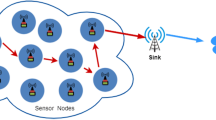Abstract
The problem of assigning power levels to the nodes of a wireless sensor network from a given a set of two power levels is called Dual power management problem and the underlying network is called Dual power network. We consider the problem of minimizing the maximum receiver interference of such a network. The interference disrupts the communication and forces the data packets to be retransmitted. The motivation is to conserve the energy by minimizing the interference and maintaining the connectivity of the dual power network. Receiver interference problem is proved to be NP-hard. In this paper, an approximation algorithm is derived for minimizing the maximum receiver interference of a dual power network by utilizing the approximation algorithm for Dual Power Management Problem. The proposed algorithm is supported by the simulation results. We term this problem as Dual Power Receiver Interference Problem and show that it is NP-complete using a polynomial time reduction from Degree Constrained Minimum Spanning Tree problem. We also prove the NP-completeness of Dual Power Management Problem by a polynomial reduction from Vertex Cover Problem.






Similar content being viewed by others
References
Abu-Affash, A.K., Carmi, P., Tzur, A.P.: Dual power assignment via second hamiltonian cycle. J. Comput. Syst. Sci. 93, 41–53 (2018). https://doi.org/10.1016/j.jcss.2017.10.002
Akyildiz, I.F., Su, W., Sankarasubramaniam, Y., Cayirci, E.: Wireless sensor networks: a survey. Comput. Netw. 38(4), 393–422 (2002). https://doi.org/10.1016/S1389-1286(01)00302-4
Buchin, K.: Minimizing the maximum interference is hard. CoRR (2008). arXiv:abs/0802.2134
Călinescu, G.: 1.61-approximation for min-power strong connectivity with two power levels. J. Comb. Optim. 31(1), 239–259 (2016). https://doi.org/10.1007/s10878-014-9738-9
Carmi, P., Chaitman-Yerushalmi, L.: On the minimum cost range assignment problem. In: Algorithms and Computation—26th International Symposium, ISAAC 2015, Nagoya, Japan, December 9–11, 2015, Proceedings, pp. 95–105 (2015). https://doi.org/10.1007/978-3-662-48971-0_9
Carmi, P., Katz, M.J.: Power assignment in radio networks with two power levels. Algorithmica 47(2), 183–201 (2007). https://doi.org/10.1007/s00453-006-1230-1
Chen, J., Lu, H., Kuo, T., Yang, C., Pang, A.: Dual power assignment for network connectivity in wireless sensor networks. In: Proceedings of the Global Telecommunications Conference, 2005. GLOBECOM ’05, St. Louis, Missouri, USA, 28 November–2 December 2005, p. 5 (2005). https://doi.org/10.1109/GLOCOM.2005.1578450
Cheng, X., Narahari, B., Simha, R., Cheng, M.X., Liu, D.: Strong minimum energy topology in wireless sensor networks: Np-completeness and heuristics. IEEE Trans. Mob. Comput. 2(3), 248–256 (2003). https://doi.org/10.1109/TMC.2003.1233530
Garey, M.R., Johnson, D.S.: Computers and Intractability: A Guide to the Theory of NP-Completeness. W. H. Freeman, New York (1979)
Halldórsson, M.M., Tokuyama, T.: Minimizing interference of a wireless ad-hoc network in a plane. Theor. Comput. Sci. 402(1), 29–42 (2008). https://doi.org/10.1016/j.tcs.2008.03.003
Hoffmann, S., Kampermann, T., Wanke, E.: Minimizing the number of max-power users in ad-hoc wireless networks with minimum node degree requirements. Inf. Process. Lett. 136, 25–29 (2018). https://doi.org/10.1016/j.ipl.2018.03.015
Lloyd, E.L., Liu, R., Ravi, S.S.: Approximating the minimum number of maximum power users in ad hoc networks. MONET 11(2), 129–142 (2006). https://doi.org/10.1007/s11036-006-4467-7
Panda, B.S., Shetty, D.P.: Strong minimum energy hierarchical topology in wireless sensor networks. J. Comb. Optim. 32(1), 174–187 (2016). https://doi.org/10.1007/s10878-015-9869-7
Pushparaj Shetty, D., Lakshmi, M.P.: Minimizing the total range with two power levels in wireless sensor networks. In: Advanced Computing and Communication Technologies, p. 183 (2019)
Rong, Y., Choi, H., Choi, H.: Dual power management for network connectivity in wireless sensor networks. In: 18th International Parallel and Distributed Processing Symposium (IPDPS 2004), CD-ROM / Abstracts Proceedings, 26–30 April 2004, Santa Fe, New Mexico, USA (2004). https://doi.org/10.1109/IPDPS.2004.1303267
Wang, C., Park, M.A., Willson, J., Farago, A., Du, D.: Fault-tolerant dual power management in wireless sensor networks. In: Proceedings of the Global Communications Conference, 2008. GLOBECOM 2008, New Orleans, LA, USA, 30 November–4 December 2008, pp. 436–441 (2008). https://doi.org/10.1109/GLOCOM.2008.ECP.91
West, D.B., et al.: Introduction to Graph Theory, vol. 2. Prentice Hall, Upper Saddle River (2001)
Acknowledgements
The authors would like to thank the National Institute of Technology Karnataka, Surathkal, for the support in this research work.
Author information
Authors and Affiliations
Corresponding author
Additional information
Publisher's Note
Springer Nature remains neutral with regard to jurisdictional claims in published maps and institutional affiliations.
Rights and permissions
About this article
Cite this article
Shetty, D.P., Lakshmi, M.P. Approximation algorithm for receiver interference problem in dual power Wireless Sensor Networks. J. Appl. Math. Comput. 61, 87–99 (2019). https://doi.org/10.1007/s12190-019-01242-5
Received:
Published:
Issue Date:
DOI: https://doi.org/10.1007/s12190-019-01242-5
Keywords
- Wireless sensor network
- Receiver interference
- Range assignment
- Dual power assignment
- Approximation algorithm




